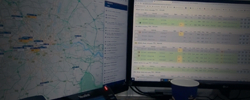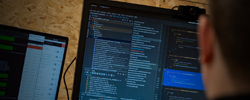We jest. But seriously, as a manufacturer, going paperless significantly enhances health and safety within your facilities. It’s actually one of the paramount advantages of making your systems digital.
How so?
Traditional paper-based processes can introduce risks, such as lost or outdated safety documents, which can lead to accidents or non-compliance with regulatory standards. Digital solutions, on the other hand, provide a robust platform for managing safety documentation, procedures, and incident reporting - and flag issues or reminders automatically.
The digitalisation of processes also brings data to the fore - something we love at Switchplane! Real-time data tracking and data analysis can identify safety trends and provide insights for continuous improvement, fostering a culture of proactive safety measures and compliance within your manufacturing environment. This crucial aspect of health and safety not only protects the well-being of your employees, but also reinforces your commitment to responsible business practices.
So, with our custom software hats on, let’s look at how going paperless can take the pain out of your health and safety practices, and enable companies to start tackling the bottom two sections of Heinrich’s ‘Accident Triangle’ through more proactive approaches.
1. Kill the spreadsheets!
In the world of Health and Safety, we don’t usually advocate killing anything, but in this case, spreadsheets are our number one on our hit list. Paperwork and spreadsheets often still dominate this field when it comes to the reporting and monitoring of health and safety.
Often, due to a lack of investment, employees who are used to carrying smart devices around in their pockets still find themselves being required to fill out paper forms, be that for equipment safety checks, incident or near-miss reporting. Manually entering data into spreadsheets from said forms is just as time-consuming, cumbersome, and error-prone. And it can also be very difficult to track the progress of any resultant actions recommended from an incident investigation or inspection.
The introduction of software can help to alleviate this stress, from task scheduling and reminders, to digitalised audit trails and automated workflows. One such example we’ve worked on for manufacturer Viking Pump Hygienic schedules checklists like First Aid and Fire Safety on rotation amongst the team to share the regulatory load. Another feature allows employees to flag issues to the responsible department, monitors the steps taken to rectify an issue, and reports back automatically to the original employee, moving the information seamlessly through the company- and providing that vital data to review and report on.
Some of your safety checks could also be automated with the use of AI, with malfunctions being detected in real-time, allowing for immediate maintenance and preventing potential accidents and downtime caused by equipment failures.
2. A grasp of the data
With health and safety monitoring data often sitting in different areas (or spreadsheets, again), it can be hard to get a solid grasp of key issues, patterns and outstanding tasks.
Creating a data platform and pulling in key data points from a range of areas enables the analysis of trends and common pitfalls. Introducing AI takes this one step further with further analysis and visualisations to produce a series of recommendations to the users for process improvements.
Having access to such concise data and conclusions can make it much easier for health and safety managers to take these recommendations to time-sapped business leaders and get agreement on actions for change. Once changes have been implemented, it’s also easy to see the impact on important KPIs.
3. Safety reporting on the ground
It can be a consistent challenge to engage employees in the health and safety process, which can result in them failing to communicate issues that occur as they come across them.
One sure way to get your engagement up is to make it as easy as possible for your staff to make a report - and we all know from experience that having to go and find the relevant form and a pen is certainly not the preferred option!. A simple mobile app in their pocket could enable them to complete safety checklists, report incidents, receive emergency notifications, and communicate seamlessly. Supervisors can capture photos, notes, and locations, instantly creating a comprehensive report accessible to the entire team. H&S on the go, as it happens!
Make UK reports that one of the organisations they support saw an increase of 70% in near-miss reporting after rolling out a mobile app for workers. This statistic in itself makes you think twice about going paperless.
Where should you start?
We appreciate that going paperless - or spreadsheetless! - can seem like a challenge in itself. But it doesn’t need to happen all at once - like any project, we recommend starting small, focusing on one pain point, putting in a simple software or app solution, testing it with your team, getting feedback, and repeating this process. It’s how we approach all software and AI implementation, in small iterative cycles over a couple of weeks. You can quickly see what works and what doesn’t quite, and make improvements.
Before you know it, you’ll be spreadsheet and paperfree, with data at your fingertips!
At Switchplane, we can provide consultancy on where best to start with going digital and look at all your systems and processes holistically. And we’re happy to work with you throughout the whole development of your digital systems too. Get in touch today and we can help you get started on that digital journey - and remove your H&S headaches along the way.
hey!
We build custom software with your team, for your team. Our apps and web platforms bring about meaningful change for businesses across the UK.
































